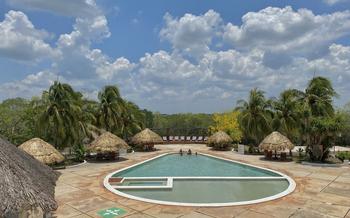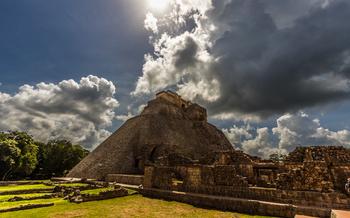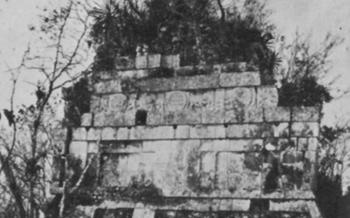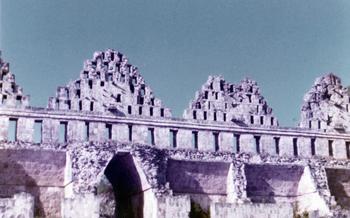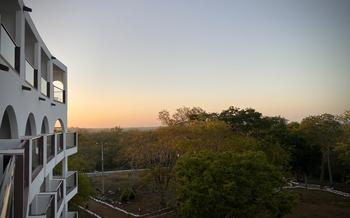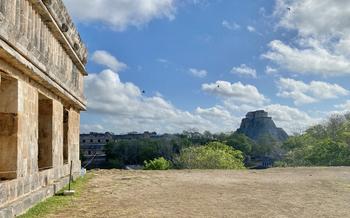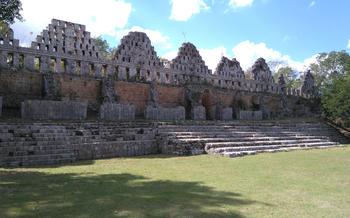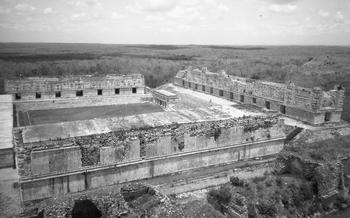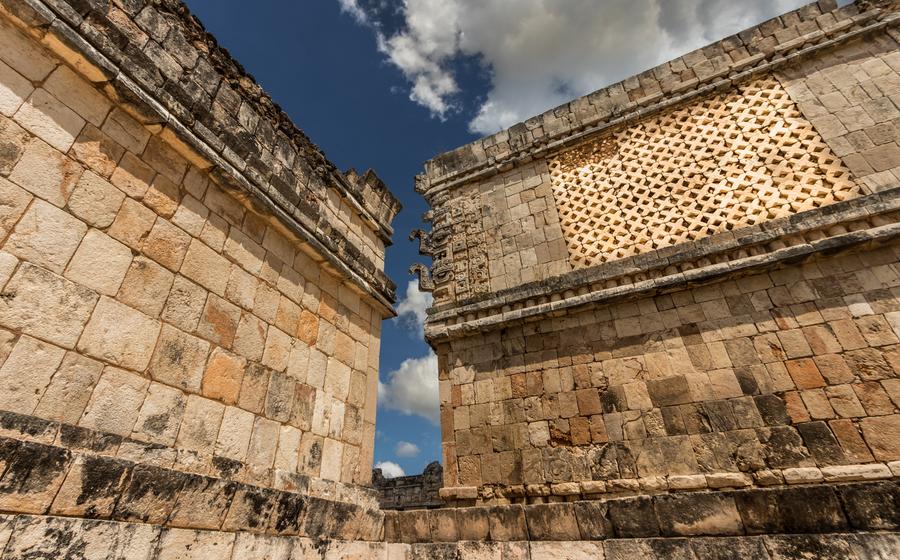
Museo de Los Altos de Jalisco
- Uxmal: A Majestic Maya City
- Museo de Los Altos de Jalisco: A Cultural Gem
- Maya Architecture and Sculpture
- The Pyramid of the Magician: A Majestic Ascent
- The Nunnery Quadrangle:
- The Great Pyramid
- The House of the Turtles:
- The Ballcourt
- Museo de Los Altos de Jalisco's Collection
- Guided Tours and Workshops:
- Getting to Uxmal and the Museum
- Insider Tip:
Uxmal: A Majestic Maya City
Uxmal, nestled in the heart of the Yucatán Peninsula, stands as a testament to the grandeur and ingenuity of the ancient Maya civilization. This remarkable city, once a vibrant metropolis, flourished during the Classic period (250-900 AD) and played a pivotal role in the region's political and cultural landscape. Its well-preserved ruins, adorned with intricate carvings and towering pyramids, offer a glimpse into the sophisticated urban planning, architectural prowess, and artistic legacy of the Maya people.
As you wander through the ancient streets of Uxmal, you'll be awestruck by the sheer scale and majesty of its structures. The city's unique architectural style, known as Puuc, is characterized by its corbelled arches, intricate geometric designs, and elaborate stone facades adorned with masks, serpents, and other mythical creatures.
Uxmal's significance extends beyond its architectural marvels. It was once a thriving center of trade, agriculture, and religious ceremonies, serving as a hub for the exchange of goods, ideas, and cultural practices. The city's strategic location along trade routes and its access to water sources contributed to its prosperity and influence.
As you explore Uxmal, immerse yourself in the history and culture of the Maya civilization, marveling at the architectural wonders that have stood the test of time. Let the ancient stones whisper tales of a glorious past, and discover the enduring legacy of this once-mighty city.
Museo de Los Altos de Jalisco: A Cultural Gem
The Museo site of Uxmal. Founded in 1976, this museum showcases the rich cultural heritage of the Maya civilization, specifically focusing on the Uxmal region.
Housed in a charming colonial-era building, the museum features an extensive collection of artifacts, sculptures, and everyday objects that provide a glimpse into the daily life, beliefs, and artistic traditions of the ancient Maya. Visitors can admire intricate pottery, finely carved jade jewelry, and ceremonial objects that once adorned the temples and palaces of Uxmal.
The museum's exhibits are organized thematically, allowing visitors to explore various aspects of Maya culture. One section focuses on the intricate writing system of the Maya, showcasing glyphs and codices that reveal their complex language and storytelling traditions. Another section delves into the religious beliefs of the Maya, featuring sculptures of deities, altars, and ceremonial objects used in their elaborate rituals.
Maya Architecture and Sculpture
The Maya civilization was renowned for its impressive architectural achievements and intricate sculptures. Uxmal showcases some of the finest examples of Maya architecture, characterized by corbelled arches, elaborate facades, and intricate carvings. The site's structures, including the Pyramid of the Magician, the Nunnery Quadrangle, and the Great Pyramid, display remarkable precision and engineering skills.
Maya sculpture is another highlight of Uxmal. The site's numerous sculptures depict a wide range of subjects, including deities, rulers, and mythological creatures. These sculptures often served as decorative elements on buildings, adding to their visual appeal and religious significance. The intricate details and symbolism found in Maya sculptures provide valuable insights into the beliefs and cultural practices of this ancient civilization.
The Pyramid of the Magician: A Majestic Ascent
At the heart of Uxmal lies the iconic Pyramid of the Magician, a towering testament to Maya architectural prowess. Constructed during the city's golden age, this pyramid is renowned for its unique elliptical shape and impressive height. Its steep sides and intricate carvings invite visitors to embark on a thrilling ascent to the summit.
Historical Significance and Symbolism: The Pyramid of the Magician holds profound historical and symbolic significance. It was built as a temple dedicated to the Maya rain god, Chaac, and served as a ceremonial center for religious rituals and astronomical observations. The pyramid's intricate carvings depict Chaac's visage, along with other deities and symbolic motifs, offering a glimpse into the Maya's spiritual beliefs and mythology.
Climbing the Pyramid: The climb to the top of the Pyramid of the Magician is a challenging yet rewarding experience. Visitors can ascend the steep stone steps, carefully navigating their way to the summit. The effort is well worth it, as the breathtaking panoramic views from the top are unparalleled. The lush jungle canopy, the sprawling archaeological site, and the distant hills create a picturesque landscape that captures the essence of Uxmal's grandeur.
Safety Precautions and Guidelines: To ensure a safe and enjoyable climb, visitors are advised to wear comfortable shoes and clothing. The steps can be slippery, especially during rainy weather, so it's essential to proceed with caution. Handrails are provided for added support, and visitors should always maintain a firm grip while ascending or descending. Respecting the pyramid's historical significance, climbing beyond the designated areas is strictly prohibited.
The Nunnery Quadrangle:
Among the many captivating structures within Uxmal, the Nunnery Quadrangle stands out for its exquisite stone carvings and intriguing history. This complex comprises four buildings arranged around a central courtyard, showcasing the architectural prowess of the ancient Maya civilization.
The most striking feature of the Nunnery Quadrangle is its intricate stone carvings. The facades of the buildings are adorned with elaborate designs depicting a variety of motifs, including geometric patterns, human figures, serpents, and mythical creatures. These carvings provide a glimpse into the rich artistic traditions and religious beliefs of the Maya people.
The historical significance of the Nunnery Quadrangle has been the subject of much debate among archaeologists and historians. While the name "nunnery" suggests a connection to religious activities, there is no definitive evidence to support this theory. Some scholars believe that the complex may have served as a palace for the ruling elite or a school for young nobles.
Despite the uncertainty surrounding its exact purpose, the Nunnery Quadrangle remains one of the most impressive and well-preserved examples of Maya architecture in Uxmal. Its intricate carvings and unique layout make it a must-see for any visitor to this ancient city.
The Great Pyramid
Of all the awe-inspiring structures at Uxmal, the Great Pyramid stands as the grandest and most emblematic. Its sheer size and remarkable architectural features make it a captivating spectacle for visitors. Towering over the other buildings, the pyramid showcases the ingenuity and craftsmanship of the ancient Maya civilization.
The Great Pyramid's dimensions are staggering, rising to a height of approximately 115 feet (35 meters) with a base measuring 180 by 140 feet (55 by 43 meters). Its imposing presence commands attention from every corner of the archaeological site. While the pyramid's exterior exudes grandeur, its interiors hold secrets that have captivated archaeologists and historians for centuries.
Extensive excavations and research have revealed a series of intricate chambers and tunnels within the pyramid. These subterranean spaces provide valuable insights into the religious and ceremonial practices of the Maya. The discovery of murals, artifacts, and skeletal remains has shed light on the pyramid's significance as a sacred burial site.
The pyramid's design exhibits remarkable precision. Its four sides are aligned with the cardinal directions, demonstrating the Maya's advanced understanding of astronomy and mathematics. The pyramid's orientation allows for the precise alignment of the sun during the spring and autumn equinoxes, creating a mesmerizing spectacle that draws visitors from around the world.
Climbing the pyramid's steep steps to the summit is a must-do experience for those seeking an unparalleled panoramic view of Uxmal. From this vantage point, visitors can marvel at the sprawling archaeological site, with its lush vegetation and towering pyramids, stretching out before them. The breathtaking vista is a reminder of the grandeur and legacy of the ancient Maya civilization.
The House of the Turtles:
Among the many captivating structures in Uxmal, the House of the Turtles stands out for its unique architectural style and intriguing symbolism. This two-story palace, named for the turtle sculptures adorning its façade, showcases the artistic prowess of the Maya people.
The House of the Turtles, or Casa de las Tortugas, features a series of terraces and vaulted rooms arranged around a central courtyard. The most striking feature of the building is its exterior decoration, which includes hundreds of finely carved turtle shells. These turtles, arranged in intricate patterns, are believed to represent the Maya creation myth, in which the world was created from a giant turtle shell.
The symbolism of the turtle in Maya culture is complex and multifaceted. Turtles are associated with fertility, longevity, and the underworld. They are also seen as protectors of the maize crop, which was essential to Maya survival. The presence of turtle motifs on the House of the Turtles suggests that the building may have been used for agricultural rituals or ceremonies related to fertility and abundance.
In addition to its symbolic significance, the House of the Turtles is also notable for its architectural features. The building's two-story design and the use of vaulted ceilings demonstrate the advanced engineering skills of the Maya. The palace's intricate carvings and bas-reliefs provide a glimpse into the artistic and cultural achievements of this ancient civilization.
The Ballcourt
Of particular interest within the archaeological site of Uxmal is the ballcourt, a testament to the cultural and ritual significance of the ancient Maya game of pok-ta-pok. This well-preserved court, measuring 87 meters in length and 13 meters in width, features two sloping sides and stone rings suspended high on the walls. These rings served as targets for the players, who aimed to bounce a solid rubber ball through them using their hips, elbows, or knees.
Beyond its sporting significance, the ballgame held deep religious and symbolic meanings for the Maya. It was believed to represent the cosmic struggle between light and darkness, with the ball representing the sun and the underworld. The outcome of the game was seen as a predictor of agricultural fertility, rainfall, and the overall well-being of the community.
The ballcourt at Uxmal is a remarkable example of the Maya's architectural prowess and their integration of ritual and sport. It invites visitors to contemplate the cultural and spiritual significance of this ancient game, which transcended mere competition and was deeply intertwined with the Maya worldview.
Museo de Los Altos de Jalisco's Collection
The Museo de Los Altos de Jalisco houses a remarkable collection of artifacts and artworks that showcase the rich cultural legacy of the region. Among the highlights of the collection are intricate pottery pieces, finely carved sculptures, and elaborately painted murals that depict scenes from daily life, religious rituals, and historical events. Visitors can admire the unique regional styles and techniques that distinguish the works of art from this diverse area.
Temporary exhibitions and special events are frequently organized at the museum, providing a platform for contemporary artists and artisans to showcase their talents and share their perspectives on traditional art forms. These exhibitions offer a dynamic and engaging way for visitors to experience the ongoing evolution of the region's artistic traditions.
Guided Tours and Workshops:
Enhance your visit to the Museo de Los Altos de Jalisco by joining a guided tour. Knowledgeable guides will provide insights into the museum's collection, the history of the region, and the significance of the various artifacts. Tours are available in English, Spanish, and other languages, ensuring that visitors from all over the world can appreciate the museum's treasures.
Group tours are ideal for families, friends, or educational groups, allowing everyone to learn together and ask questions. Alternatively, private tours offer a more personalized experience, catering to specific interests and providing in-depth knowledge. Reservations for guided tours can be made in advance to secure a spot, especially during peak tourist seasons.
The museum also organizes hands-on workshops, providing visitors with a unique opportunity to immerse themselves in the culture and traditions of the region. These workshops may include traditional crafts, cooking classes, or interactive activities that allow visitors to create their own souvenirs. Workshops are a great way to engage with the local community and gain a deeper understanding of the region's heritage.
Getting to Uxmal and the Museum
Reaching Uxmal and the Museo de Los Altos de Jalisco is a breeze, with various transportation options available. If you're driving, follow the well-maintained roads leading to the archaeological site, where ample parking is provided for visitors. Alternatively, you can hop on a comfortable bus from nearby cities like Mérida or Campeche, which offer regular departures throughout the day.
Once you arrive at the archaeological site, the museum is conveniently located within its grounds. Simply follow the signs or ask for directions from the friendly staff. The museum's entrance is clearly marked, and you'll find yourself immersed in the captivating world of Maya culture the moment you step inside.
Insider Tip:
Explore beyond the main attractions of Uxmal and the museum to discover hidden gems that often go unnoticed. Take a leisurely stroll through the surrounding forest to find secluded ruins and ancient trails. Capture stunning photographs of the site during the golden hours of sunrise and sunset, when the warm light casts a magical glow on the ancient structures. For a unique souvenir, visit local markets or artisan shops to find handcrafted items inspired by Maya culture. Indulge in the local cuisine by trying traditional Maya dishes at nearby restaurants, and don't forget to sample the refreshing local beverages, such as horchata or jamaica water. Immerse yourself in the vibrant culture of Uxmal by engaging with the friendly locals, who are always eager to share their stories and traditions.

